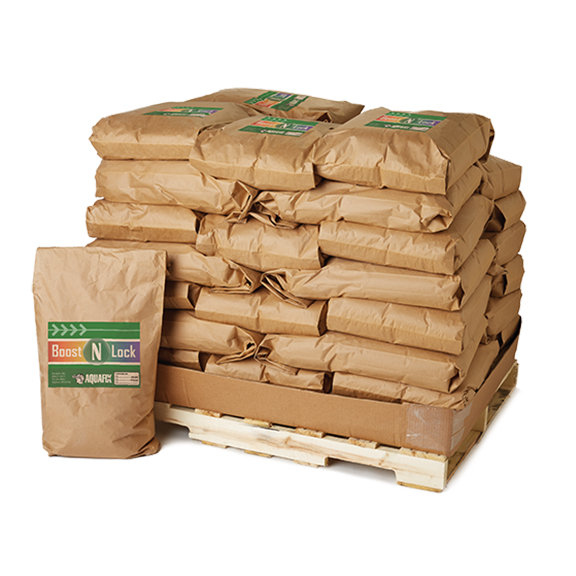Boost N Lock
Boost N Lock offers a reliable solution for achieving and maintaining neutral pH levels. It is a premium blend of alkalinity agents like magnesium hydroxide, hydrated lime, sodium bicarbonate, and sodium carbonate in specific proportions. The combination of these ingredients provides superior pH stabilization when compared to lime, soda ash, or sodium hydroxide.
Safe and Effective pH Management: Effectively raise the pH to neutral and maintain it, providing stability in both aerobic and anaerobic wastewater systems.
Optimal Alkalinity Sources: Combines magnesium hydroxide, hydrated lime, sodium bicarbonate, and sodium carbonate in precise proportions for superior pH stabilization compared to traditional methods.
Enhances System Efficiency: This unique blend not only adjusts pH but also provides significant buffering capacity to prevent pH fluctuations.
$128.00
Safe and Effective pH Management: Effectively raise the pH to neutral and maintain it, providing stability in both aerobic and anaerobic wastewater systems.
Optimal Alkalinity Sources: Combines magnesium hydroxide, hydrated lime, sodium bicarbonate, and sodium carbonate in precise proportions for superior pH stabilization compared to traditional methods.
Enhances System Efficiency: This unique blend not only adjusts pH but also provides significant buffering capacity to prevent pH fluctuations.
| Anaerobic Digester Dosing: Starting pH Greater Than 6 | ||
|---|---|---|
| Digester Capacity (Gallons) | Initial Dose (per day, until pH is neutral) | Maintenance Dose (Once per day, or as needed) |
| 100,000 GPD | 60 lb | 5 lb |
| 500,000 GPD | 300 lb | 25 lb |
| 1 MGD | 600 lb | 50 lb |
| WWTP Dosing: Staring pH Greater Than 6 | ||
|---|---|---|
| Digester Capacity (Gallons) | Initial Dose (per day, until pH is neutral) | Maintenance Dose (Once per day, or as needed) |
| 100,000 GPD | 40 lb | 3 lb |
| 500,000 GPD | 200 lb | 15 lb |
| 1 MGD | 400 lb | 30 lb |
Product Details
Magnesium hydroxide is a great additive if the starting pH is less than 6. If this is your starting point, ask your technical rep about pricing and dosing for our pure magnesium hydroxide to get the pH adjustment process started. Boost N Lock provides buffering capacity and works to stabilize the pH. Boost N Lock can also be used to make minor increases in pH. Our technical team can advise on pH adjustments.
The Science Behind It
Boost N Lock was developed from the continual supply of wastewater samples coming through our lab and customers asking for the easiest and safest means of stabilizing their pH. The combination of hydroxide, carbonate, and bicarbonate alkalinity, combined with beneficial cations calcium and magnesium makes this an ideal choice. Methods of raising the pH tend to be more straightforward while stabilizing the pH is a larger challenge for most wastewater operators. This product will buffer water in a way the individual ingredients cannot. This unique blend is excellent at buffering the pH efficiently and safely and is great for modest pH adjustments.
Boost N lock is recommended when the pH is 6.0 or higher and the customer wants to get into a pH 7.0 to 8.0 range. When the pH is lower than 6.0 we recommend our high-purity magnesium hydroxide product to get the pH up into the 6 range and then our Boost N Lock to stabilize and hold the pH. In these low pH, magnesium hydroxide has high solubility and as the pH goes higher the solubility decreases and it forms sludge. For this reason, Boost N Lock only contains a small amount of magnesium hydroxide which allows us to get the benefits of the product without creating sludge at high pH.
Aerobic Wastewater Processes and Calcium/Magnesium Bridging to Improve Floc Formation
In addition to being effective at maintaining a balanced pH, Boost N Lock contains high levels of calcium and magnesium which have demonstrated an ability to improve floc formation by improving calcium/magnesium bridging. Higher levels of the cations calcium and magnesium alter the surface charge of EPS (exocellular polysaccarides) in a way that provides more consistent floc formation. Typically, this means the higher the ratio of calcium and magnesium to sodium and potassium the better the floc formation.
Raising the pH in an Anaerobic Digester
Increasing the pH in an anaerobic digester can be difficult for several reasons:
Typically, inexpensive methods, such as hydrated lime, are insoluble which lead to excess sludge accumulation in a digester. Lime sludge interferes with mixing and reduces digester capacity which can lead to extra hauling and reduced methane generation.
Sodium hydroxide is soluble and can increase pH quickly, but is hazardous and has a risk of overshooting the pH. Baking soda would be a good option due to its high solubility and excellent buffering capacity, but tends to require high volumes to adjust the pH in a digester effectively and can lead to sodium toxicity.
For these reasons we recommend first adjusting the pH of the digester in question with our high-purity magnesium hydroxide to pH 6-7, then using Boost N Lock to bring the pH in the 7’s to promote stability. Boost N Lock can then be used as a low-dose maintenance tool to maintain good alkalinity, preventing future digester upsets.

